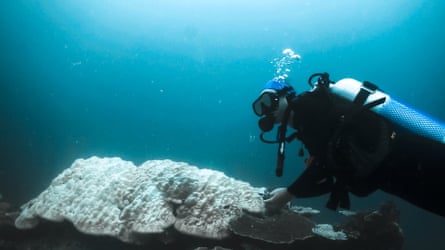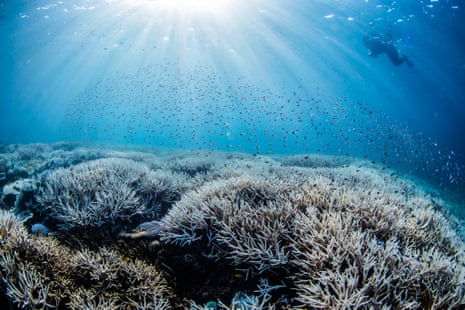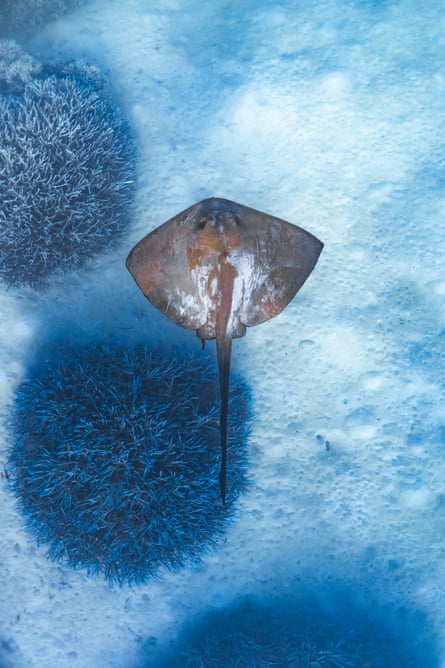“You can see it on their faces,” says scuba diving instructor Elliot Peters. “There’s definitely some remorse and sadness.”
Peters works at a resort on Heron Island in the southern part of the Great Barrier Reef and, in recent weeks, he’s had to tell curious guests why so many of the corals around the island are turning bone white.
The reef is in the middle of its fifth mass bleaching event in only eight years – an alarming trend driven by global heating in a year that has seen record global ocean temperatures.
Peters has never seen a mass coral bleaching event up close before, but this summer he’s seen ancient boulder corals that can live for hundreds of years bleaching and showing signs of death.
“If anything it’s motivating me,” he says. “It’s opening the doors to get people talking about climate change and the health of the reef. People are thanking us for telling the truth about what’s going on here.”
The Great Barrier Reef is a major export industry for Australia, with one 2017 report estimating the reef supports 64,000 jobs and contributes $6.4bn to the national economy.
But as the impact of global heating on the reef made global headlines in 2016 and 2017, tensions in the tourism industry started to emerge. One tourism head called stories of catastrophic bleaching a “great white lie”.
“The reef is the most significant natural attraction that this country has to offer,” says Daniel Gschwind, a professor at Griffith University’s tourism institute and the chair of the committee that represents reef tourism to the government’s Great Barrier Reef Marine Park Authority.
“It’s a challenge because as a phenomenon, [global heating] is affecting what we ultimately sell.”
Sign up for a weekly email featuring our best reads
‘If the reef dies, we die’
Gschwind says for many years, tourism operators were reluctant to talk to guests about the threat of climate breakdown.
The reef has experienced mass bleaching in 2002, 2016, 2017, 2020, 2022 and now again in 2024. But for an ecosystem the size of Italy, the effects are not uniform.
What is coral bleaching?
Show
Coral bleaching describes a process where the coral animal expels the algae that live in their tissues and give them their colour and much of their nutrients.
Without their algae, a coral’s white skeleton can be seen through their translucent flesh, giving a bleached appearance.
Mass coral bleaching over large areas, first noticed in the 1980s around the Caribbean, is caused by rising ocean temperatures.
Some corals also display fluorescent colours under stress when they release a pigment that filters light. Sunlight also plays a role in triggering bleaching.
Corals can survive bleaching if temperatures are not too extreme or prolonged. But extreme marine heatwaves can kill corals outright.
Coral bleaching can also have sub-lethal effects, including increased susceptibility to disease and reduced rates of growth and reproduction.
Scientists say the gaps between bleaching events are becoming too short to allow reefs to recover.
Coral reefs are considered one of the planet’s ecosystems most at risk from global heating. Reefs support fisheries that feed hundreds of millions of people, as well as supporting major tourism industries.
The world’s biggest coral reef system – Australia’s Great Barrier Reef – has suffered seven mass bleaching events since 1998, of which five were in the past decade.
In any given year, some reefs escape the heat stress, some turn white but then regain their colour, while some corals will die. Bleaching can make corals more susceptible to disease, slow their growth and impede their reproduction.
Government scientists were this week carrying out in-water and aerial surveys to assess the bleaching across the whole reef, but it could be weeks, or even months, before there’s a clear picture of how severe this year has been.
The long-term prognosis for the reef is not good. As global heating continues, the chances of ever more intense heat stress events is rising.
 View image in fullscreen
View image in fullscreen
“It’s difficult to communicate a bleaching event accurately,” says Gschwind. “With an event like this one, by the time it’s communicated to a consumer in London or Shanghai the message received could be ‘the reef is not worth visiting any more’. That’s the challenge to the tourism industry and it’s why many operators struggle with this.”
Divers on tourism boats are often the first to raise the alarm, and this year operators have sent more than 5,000 observations to the marine park authority.
“That’s where the industry and operators see their social role. They’re the communicators of this story – operators are the sentinels,” says Gschwind.
“They see what global warming is doing to the natural environment that we all depend on. If the reef dies, then we die. We’re the early warning system for what’s going on on the planet.”
 View image in fullscreen
View image in fullscreen
The emotional toll of a bleached reef
Since back-to-back mass bleaching events in 2016 and 2017, the park authority has worked with the tourism industry to establish Master Reef Guides, a growing cohort of more than 120 dive professionals trained by scientists and traditional owners on how to communicate the health of the reef and its threats.
Fiona Merida, a marine biologist and director of reef education and engagement at the park authority, says giving tourism operators detailed information on what was happening at the sites they visited “takes the emotion out of it” and gives them confidence to talk to visitors about bleaching.
But she says some reef guides are themselves suffering “ecological grief” this year at seeing the places they love suffer. Reef guides have established a “buddy check” system where guides can check in on each other’s mental health.
Yolanda Waters is founder of advocacy group Divers for Climate and has been diving in the southern section of the reef in recent weeks.
skip past newsletter promotionSign up to Five Great Reads
Each week our editors select five of the most interesting, entertaining and thoughtful reads published by Guardian Australia and our international colleagues. Sign up to receive it in your inbox every Saturday morning
after newsletter promotion
You have climate sceptics in every group, but I find that’s becoming less and lessTahn Miller, dive instructor
“It was bleached coral as far as the eye could see,” she says. “I didn’t want to get back into the water. It’s a restorative place for me and to not want to go back in is awful.”
Waters is a former dive instructor and as part of research at the University of Queensland, she has interviewed more than 650 reef visitors in recent years.
“I noticed how difficult these conversations were,” she says. “Tourists ask a lot of questions and it can feel confronting if people have paid $300 to go on to the reef. A big question tourism gets asked is: ‘Is the reef dying? Tell me.’
“The reality is far more complicated, but they want to know from the people who see the reef every day.
“We found [tourists] are actually open to hearing about climate change. In fact the majority weren’t only open to the information, but wanted more. And they wanted to know what they could do.”
“It’s a tricky line: how do we do this in a way that motivates action and does not turn people off? But you have to face the reality – there is still so much to save, and that gets left out a lot.”
 View image in fullscreen
View image in fullscreen
‘The time is now’
Tahn Miller has been working as a dive instructor and guide at Wavelength Reef Cruises in Port Douglas in far north Queensland for 15 years.
Miller remembers hearing stories from a decade ago of how some dive guides in other parts of the reef would be told not to mention climate change to guests for fear of perpetuating ideas the natural treasure was either dying or not worth visiting.
But he says there’s been an evolution in the industry, and now far more divers are feeling empowered to talk to visitors about the climate crisis – but only if the visitors want to hear it.
“You have climate sceptics in every group, but I find that’s becoming less and less,” he says. “I tell them I’m not there to change anyone’s minds, but this is what I have witnessed. I try and be honest with them.”
Miller says after the 2016 bleaching, he saw reefs recovering. But his optimism has been eroded in recent years.
There are several tour operators that are also running small reef restoration projections in the areas they visit, including replanting corals.
“Some of the corals I’ve planted – hundreds of them – have already died [this summer],” he says.
“The time is now … we have to make change because if we don’t, we lose massive expanses of reef.”
Back on Heron Island, Peters says he gets stopped by tourists asking him what they can do to help the reef.
“I start by getting them to acknowledge their appreciation for the reef and that we have to do more. I leave them with one or two tips,” he says.
“I say they should ‘use their voice’ and find out about the policies of the people they might vote for. And I ask them to think about where their money is being held – is it in a bank that invests in fossil fuels?”
∎